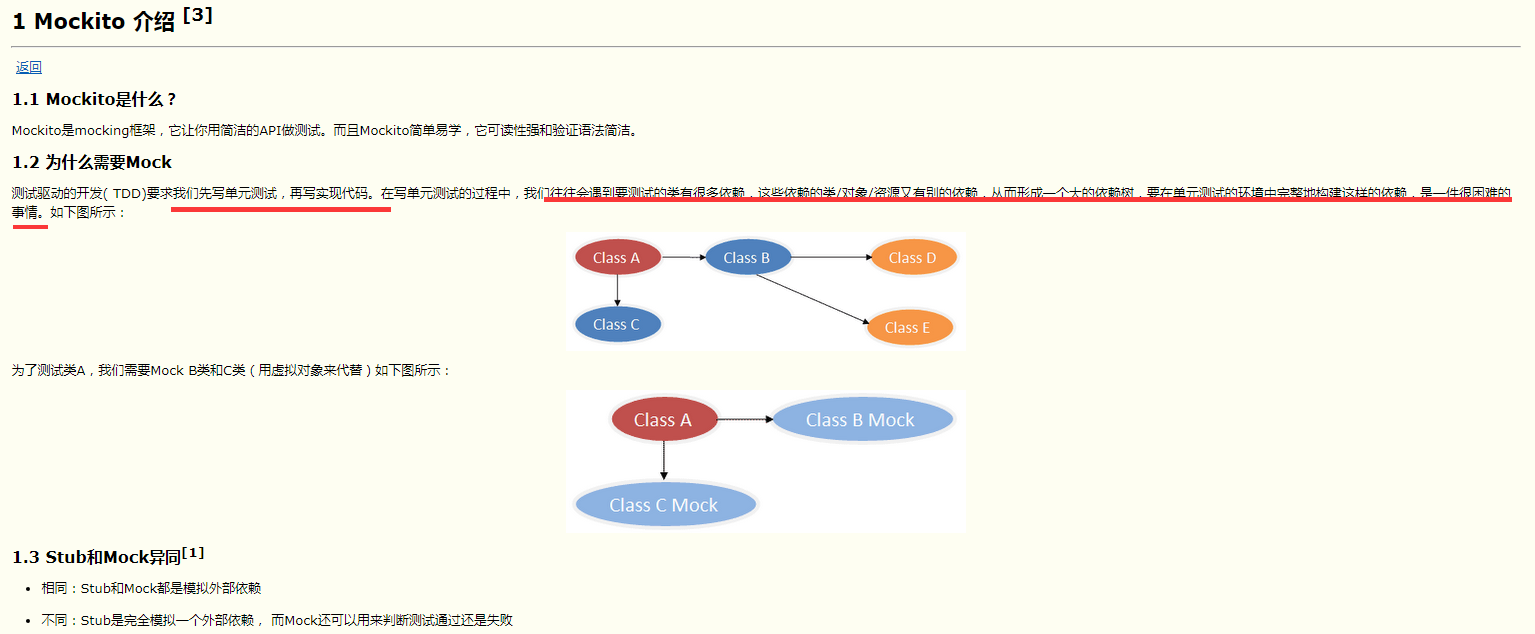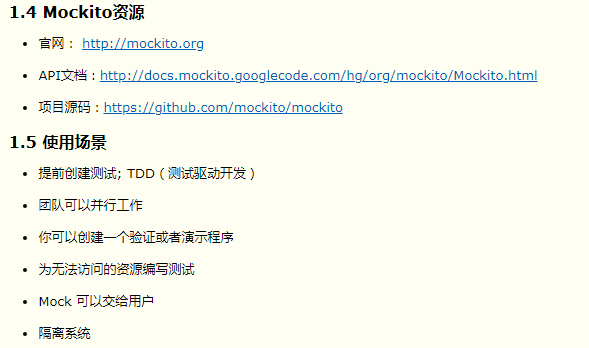PS: 学习网址
PS: Mockito就是为了测试使用


package com.beet.test.yangqiang; import static org.mockito.Mockito.*; import static org.junit.Assert.*; import java.io.IOException; import java.io.OutputStream; import java.io.OutputStreamWriter; import java.util.ArrayList; import java.util.Arrays; import java.util.Comparator; import java.util.Iterator; import java.util.LinkedList; import java.util.List; import org.junit.Test; import org.mockito.ArgumentCaptor; import org.mockito.ArgumentMatcher; import org.mockito.InOrder; import org.mockito.exceptions.verification.NoInteractionsWanted; import org.mockito.invocation.InvocationOnMock; import org.mockito.stubbing.Answer; /** * Hello world! * */ public class App { /*public static void main( String[] args ) { System.out.println( "Hello World!" ); }*/ /** * 验证行为 */ @Test public void verify_behaviour(){ //模拟创建一个List对象 List mock = mock(List.class); //使用mock的对象 mock.add(1); mock.clear(); //验证add(1)和clear()行为是否发生 verify(mock).add(1); verify(mock).clear(); } /** * 模拟我们需要的结果 */ @Test public void when_thenReturn(){ //mock一个Iterator类 Iterator iterator = mock(Iterator.class); //预设当iterator调用next()时第一次返回hello,第n次都返回world when(iterator.next()).thenReturn("hello").thenReturn("world"); //使用mock的对象 String result = iterator.next() + " " + iterator.next() + " " + iterator.next(); //验证结果 assertEquals("hello world world",result); } @Test(expected = IOException.class) public void when_thenThrow() throws IOException { OutputStream outputStream = mock(OutputStream.class); OutputStreamWriter writer = new OutputStreamWriter(outputStream); //预设当流关闭时抛出异常 doThrow(new IOException()).when(outputStream).close(); outputStream.close(); } /*2.3 RETURNS_SMART_NULLS和RETURNS_DEEP_STUBS*/ @Test public void returnsSmartNullsTest() { List mock = mock(List.class, RETURNS_SMART_NULLS); System.out.println(mock.get(0)); //使用RETURNS_SMART_NULLS参数创建的mock对象,不会抛出NullPointerException异常。另外控制台窗口会提示信息“SmartNull returned by unstubbed get() method on mock” System.out.println(mock.toArray().length); } @Test public void deepstubsTest(){ Account account=mock(Account.class,RETURNS_DEEP_STUBS); when(account.getRailwayTicket().getDestination()).thenReturn("Beijing"); account.getRailwayTicket().getDestination(); verify(account.getRailwayTicket()).getDestination(); assertEquals("Beijing",account.getRailwayTicket().getDestination()); } @Test public void deepstubsTest2(){ Account account=mock(Account.class); RailwayTicket railwayTicket=mock(RailwayTicket.class); when(account.getRailwayTicket()).thenReturn(railwayTicket); when(railwayTicket.getDestination()).thenReturn("Beijing"); account.getRailwayTicket().getDestination(); verify(account.getRailwayTicket()).getDestination(); assertEquals("Beijing",account.getRailwayTicket().getDestination()); } /** * 模拟方法体抛出异常 */ @Test(expected = RuntimeException.class) public void doThrow_when(){ List list = mock(List.class); doThrow(new RuntimeException()).when(list).add(1); list.add(1); } /** * 参数匹配 */ @Test public void with_arguments(){ Comparable comparable = mock(Comparable.class); //预设根据不同的参数返回不同的结果 when(comparable.compareTo("Test")).thenReturn(1); when(comparable.compareTo("Omg")).thenReturn(2); assertEquals(1, comparable.compareTo("Test")); assertEquals(2, comparable.compareTo("Omg")); //对于没有预设的情况会返回默认值 assertEquals(0, comparable.compareTo("Not stub")); } @Test public void with_unspecified_arguments(){ List list = mock(List.class); //匹配任意参数 when(list.get(anyInt())).thenReturn(1); when(list.contains(argThat(new IsValid()))).thenReturn(true); assertEquals(1, list.get(1)); assertEquals(1, list.get(999)); assertTrue(list.contains(1)); assertTrue(!list.contains(3)); } @Test public void all_arguments_provided_by_matchers(){ Comparator comparator = mock(Comparator.class); comparator.compare("nihao","hello"); //如果你使用了参数匹配,那么所有的参数都必须通过matchers来匹配 verify(comparator).compare(anyString(),eq("hello")); //下面的为无效的参数匹配使用 //verify(comparator).compare(anyString(),"hello"); } @Test public void argumentMatchersTest(){ //创建mock对象 List<String> mock = mock(List.class); //argThat(Matches<T> matcher)方法用来应用自定义的规则,可以传入任何实现Matcher接口的实现类。 when(mock.addAll(argThat(new IsListofTwoElements()))).thenReturn(true); mock.addAll(Arrays.asList("one","two","three")); //IsListofTwoElements用来匹配size为2的List,因为例子传入List为三个元素,所以此时将失败。 verify(mock).addAll(argThat(new IsListofTwoElements())); } @Test public void capturing_args(){ PersonDao personDao = mock(PersonDao.class); PersonService personService = new PersonService(personDao); ArgumentCaptor<Person> argument = ArgumentCaptor.forClass(Person.class); personService.update(1,"jack"); verify(personDao).update(argument.capture()); assertEquals(1,argument.getValue().getId()); assertEquals("jack",argument.getValue().getName()); } /** * 返回规定的期望结构 */ @Test public void answerTest(){ List<String> mockList = mock(List.class); when(mockList.get(anyInt())).thenAnswer(new CustomAnswer()); assertEquals("hello world:0",mockList.get(0)); assertEquals("hello world:999",mockList.get(999)); } @Test public void unstubbed_invocations(){ //mock对象使用Answer来对未预设的调用返回默认期望值 List mock = mock(List.class,new Answer() { public Object answer(InvocationOnMock invocation) throws Throwable { return 999; } }); //下面的get(1)没有预设,通常情况下会返回NULL,但是使用了Answer改变了默认期望值 assertEquals(999, mock.get(1)); //下面的size()没有预设,通常情况下会返回0,但是使用了Answer改变了默认期望值 assertEquals(999,mock.size()); } @Test(expected = IndexOutOfBoundsException.class) public void spy_on_real_objects(){ List list = new LinkedList(); List spy = spy(list); //下面预设的spy.get(0)会报错,因为会调用真实对象的get(0),所以会抛出越界异常 //when(spy.get(0)).thenReturn(3); //使用doReturn-when可以避免when-thenReturn调用真实对象api doReturn(999).when(spy).get(999); //预设size()期望值 when(spy.size()).thenReturn(100); //调用真实对象的api spy.add(1); spy.add(2); assertEquals(100,spy.size()); assertEquals(1,spy.get(0)); assertEquals(2,spy.get(1)); verify(spy).add(1); verify(spy).add(2); assertEquals(999,spy.get(999)); spy.get(2); } @Test public void real_partial_mock(){ //通过spy来调用真实的api List list = spy(new ArrayList()); assertEquals(0,list.size()); A a = mock(A.class); //通过thenCallRealMethod来调用真实的api when(a.doSomething(anyInt())).thenCallRealMethod(); assertEquals(999,a.doSomething(999)); } @Test public void reset_mock(){ List list = mock(List.class); when(list.size()).thenReturn(10); list.add(1); assertEquals(10,list.size()); //重置mock,清除所有的互动和预设 reset(list); assertEquals(0,list.size()); } @Test public void verifying_number_of_invocations(){ List list = mock(List.class); list.add(1); list.add(2); list.add(2); list.add(3); list.add(3); list.add(3); //验证是否被调用一次,等效于下面的times(1) verify(list).add(1); verify(list,times(1)).add(1); //验证是否被调用2次 verify(list,times(2)).add(2); //验证是否被调用3次 verify(list,times(3)).add(3); //验证是否从未被调用过 verify(list,never()).add(4); //验证至少调用一次 verify(list,atLeastOnce()).add(1); //验证至少调用2次 verify(list,atLeast(2)).add(2); //验证至多调用3次 verify(list,atMost(3)).add(3); } @Test(expected = RuntimeException.class) public void consecutive_calls(){ List mockList = mock(List.class); //模拟连续调用返回期望值,如果分开,则只有最后一个有效 when(mockList.get(0)).thenReturn(0); when(mockList.get(0)).thenReturn(1); when(mockList.get(0)).thenReturn(2);//--只有这个有效 when(mockList.get(1)).thenReturn(0).thenReturn(1).thenThrow(new RuntimeException()); assertEquals(2,mockList.get(0)); assertEquals(2,mockList.get(0)); assertEquals(0,mockList.get(1)); assertEquals(1,mockList.get(1)); //第三次或更多调用都会抛出异常 mockList.get(1); mockList.get(1); } @Test public void verification_in_order(){ List list = mock(List.class); List list2 = mock(List.class); list.add(1); list2.add("hello"); list.add(2); list2.add("world"); //将需要排序的mock对象放入InOrder InOrder inOrder = inOrder(list,list2); //下面的代码不能颠倒顺序,验证执行顺序 inOrder.verify(list).add(1); inOrder.verify(list2).add("hello"); inOrder.verify(list).add(2); inOrder.verify(list2).add("world"); } @Test public void verify_interaction(){ List list = mock(List.class); List list2 = mock(List.class); List list3 = mock(List.class); list.add(1); verify(list).add(1); verify(list,never()).add(2); //验证零互动行为 verifyZeroInteractions(list2,list3); } @Test(expected = NoInteractionsWanted.class) public void find_redundant_interaction(){ List list = mock(List.class); list.add(1); list.add(2); verify(list,times(2)).add(anyInt()); //检查是否有未被验证的互动行为,因为add(1)和add(2)都会被上面的anyInt()验证到,所以下面的代码会通过 verifyNoMoreInteractions(list); List list2 = mock(List.class); list2.add(1); list2.add(2); verify(list2).add(1); //检查是否有未被验证的互动行为,因为add(2)没有被验证,所以下面的代码会失败抛出异常 verifyNoMoreInteractions(list2); } } class A{ public int doSomething(int i){ return i; } } class CustomAnswer implements Answer<String>{ public String answer(InvocationOnMock invocation) throws Throwable { Object[] args = invocation.getArguments(); return "hello world:"+args[0]; } } class IsListofTwoElements extends ArgumentMatcher<List> { public boolean matches(Object list) { return((List)list).size()==2; } } class IsValid extends ArgumentMatcher<List>{ @Override public boolean matches(Object o) { return o.equals(1) || o.equals(2); } } class Person{ private int id; private String name; Person(int id, String name) { this.id = id; this.name = name; } public int getId() { return id; } public String getName() { return name; } } interface PersonDao{ public void update(Person person); } class PersonService{ private PersonDao personDao; PersonService(PersonDao personDao) { this.personDao = personDao; } public void update(int id,String name){ personDao.update(new Person(id,name)); } }